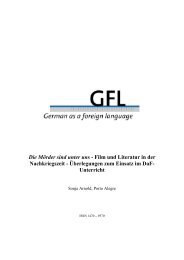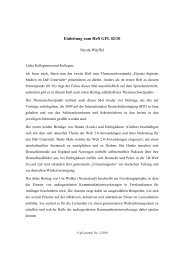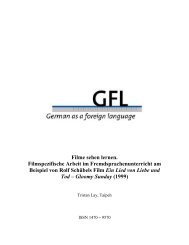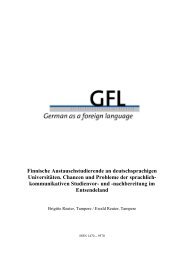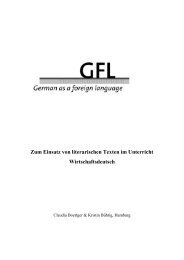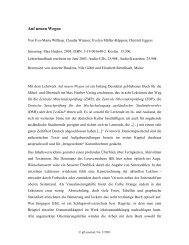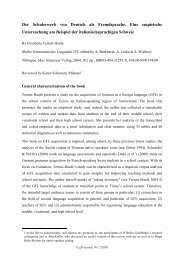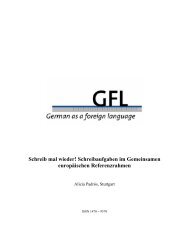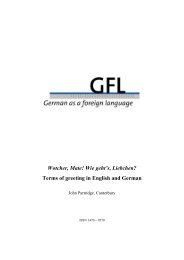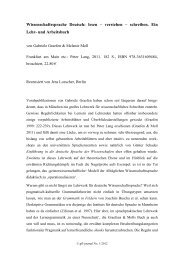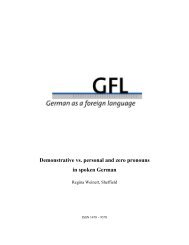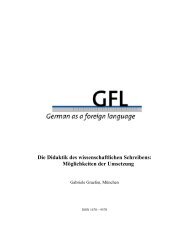Drama and Authentic Movement as Intercultural ... - GFL
Drama and Authentic Movement as Intercultural ... - GFL
Drama and Authentic Movement as Intercultural ... - GFL
Create successful ePaper yourself
Turn your PDF publications into a flip-book with our unique Google optimized e-Paper software.
<strong>Drama</strong> <strong>and</strong> <strong>Authentic</strong> <strong>Movement</strong> <strong>as</strong> <strong>Intercultural</strong> Communication Skill<br />
127<br />
Like Janet Adler, Joan Chodorow is a founding advisor of the <strong>Authentic</strong> <strong>Movement</strong><br />
Institute.<br />
<strong>Authentic</strong> <strong>Movement</strong> does not have a specific theoretical b<strong>as</strong>is. It h<strong>as</strong> evolved, <strong>and</strong><br />
continues to evolve, out of the exploratory work of its practitioners <strong>and</strong> is influenced by<br />
Modern Dance, Ausdruckstanz, <strong>as</strong> well <strong>as</strong> psychotherapeutic theories <strong>and</strong> methods. Dietmar<br />
E. Pall<strong>as</strong>ch describes in his PhD thesis within the field of dance therapy how he explored<br />
the similarities between <strong>Authentic</strong> <strong>Movement</strong> <strong>and</strong> related psychotherapeutic theories such<br />
<strong>as</strong> the theories of C.G. Jung, Arnold Mindell, Carl Rogers <strong>and</strong> Eugene Gendlin <strong>and</strong>, indeed,<br />
further research into this area is needed. 6<br />
2.2 The Form<br />
“<strong>Authentic</strong> <strong>Movement</strong> explores the relationship between a mover <strong>and</strong> a witness, being seen<br />
<strong>and</strong> seeing.” 7<br />
The b<strong>as</strong>ic form of <strong>Authentic</strong> <strong>Movement</strong> is a dyadic form which includes a mover <strong>and</strong> a<br />
witness. There is no movement instruction in <strong>Authentic</strong> <strong>Movement</strong>, simply a mover <strong>and</strong> a<br />
witness. These roles usually interchange within a session, except in a therapeutic context.<br />
During a set timed session, the mover closes his or her eyes <strong>and</strong> allows inner physical or<br />
vocal impulses to guide his or her movement. The mover’s eyes are closed in order to<br />
attend more deeply to his or her kinaesthetic or inner experience. The movements may or<br />
may not be visible to the witness. The movements <strong>and</strong>/or sounds may be in response to an<br />
emotion, a dream, a thought, pain, joy, or whatever is being experienced at a given<br />
moment. The witness sits on the edge of the movement space - in the c<strong>as</strong>e of a group, in a<br />
circle <strong>and</strong> attends to both the mover <strong>and</strong> his or her own internal responses to the movement.<br />
Chodorow 1996: 11-12.<br />
6<br />
Pall<strong>as</strong>ch, Dietmar E. (2002): Tief bewegt zum Ziel. Ein tanztherapeutischer Ansatz aus NLP und<br />
<strong>Authentic</strong> <strong>Movement</strong>, Bielefeld: Junfermann Verlag, 6, 10-11.<br />
7<br />
Introduction on the homepage of the <strong>Authentic</strong> <strong>Movement</strong> Institute in San Francisco,<br />
http://www.authenticmovement-usa.com<br />
© gfl-journal, No. 1/2004



